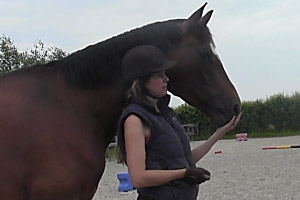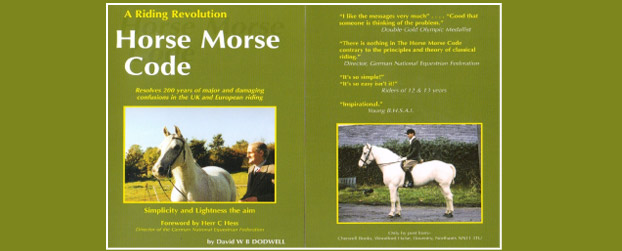An Article published in Tracking-Up Magazine. Winter 2011
THE ‘HORSE MORSE CODE’
by Kat Layfield
‘The Lord says: “Call to me and I will answer you and tell you great and unsearchable things you do not know." The Prophet Jeremiah, Chapter 33, Verse 3
In 1997 I was searching for a compassionate dressage trainer who followed the principles of classical dressage theory and who was committed to using training methods that had a positive impact on the physiological and psychological welfare of the horses they trained. I was fortunate to find David Dodwell and began training with this modern day past master.
David Dodwell was, as well as possessing other riding talents, a Grand Prix dressage rider in the 1970s. Whilst producing his first Grand Prix horse he found the existing systems of training not simple, unclear and often ambiguous, leading to confusion. The lack of clarity and consistency exhibited within these traditional equine training systems by default also produced a high incidence of physiological and psychological resistance in horses. David therefore decided to develop a system of training the riding horse that could produce a high school horse but would be as clear to the horse and rider as the radio Morse Code was to its users. (The Morse Code has recently been ‘retired’ due to having been superseded by modern technological means of communication.) Over a period of many years he developed a complete system of training the riding horse, a riding system that became known as the 'Horse Morse Code', with the ‘mission statement’ of ‘Simplicity and Lightness the aim’.
The system is based upon the best parts of the teachings of five great past masters - Francois De La Gueriniere, James Fillis, General De Carpentry, Alois Podhahjsky and Dr Reine Klimke. The system comprises 17 unequivocal messages (aids) composed of specific combinations of rider's hand and leg, which are taught carefully and clearly, using negative reinforcement and secondary positive reinforcement to reinforce only the desired response. Conditioning a horse to respond to all 17 messages produces a dressage horse capable of performing all required Grand Prix and high school movements, although most riders’ activities require only 12 of them.
The messages provide the horse with specific, consistent tactile stimuli ensuring each message presentation possesses the same clarity as the Morse Code, allowing equine discrimination capabilities to be optimised and confused and resistant behaviour to be eliminated. The system strongly opposes the use of gadgets and is almost foolproof, benefiting all horse and rider combinations, regardless of the equine’s age, type, breed, level of training or previous training system used. The system fulfils the Federation Equestre Internationale (FEI's) seven basic requirements for the dressage horse and David's book 'A Riding Revolution - Horse Morse Code' was published with a Foreword by Herr Christoph Hess, Director of the German Equestrian Federation.
I was fortunate enough to have many lessons with David, on my own and clients’ horses and on his horses (including his beloved Pharaoh). I experienced first-hand how his horses felt during lateral work, piaffe, passage and Spanish walk and can honestly say that they were all ‘normal horses’, trained using his system to be the lightest and most active, motivated and responsive horses I had ever ridden.
In 1997 there was almost no scientifically published research on how different training systems related to equine learning theory (how horses learn and understand) and David's meticulous development of a concise, consistent system lent itself perfectly to this area of study. With David's full support I based my equine behavioural thesis on this topic and was invited as a guest speaker to present the results of the study at the Equine Behaviour Forum’s 25th Birthday Scientific Symposium at De Montfort University in 1999.
The more recent interest in Equitation Science (forefronted by Andrew Mclean of the Australian Equine Behaviour Centre (AEBC) and the fantastic training system of Philippe Karl who showcasing his ‘School of Légèreté’ has worked hard to highlight the differences between ‘classical’ and ‘modern’ dressage. This is now reaching greater audiences and is increasing riders’ awareness and knowledge of equine learning theory and the importance of using appropriate training systems, with true lightness the aim. The Horse Morse Code undoubtedly stands amongst these more logical and humane systems of training riding horses.
It was with great sadness that we heard that David passed away in 2010. To the end, his passion and keenness to spread the message about his system was unfaltering and his knowledge, expertise and wisdom regarding it was incredible. He talked so often about the works of the great equine past masters but without realising it he was one himself. David was a fabulous mentor and the legacy he leaves us with is his book, A Riding Revolution – Horse Morse Code, also the riders he trained and the improvements he made to the welfare of the riding horse. His family and others continue to use his system and his revised edition of his book is readily available (see Bibliography below).
Glossary
Desired Response – The behaviour the trainer or rider wants the horse to perform. The desired behaviour is often broken down into lots of little desired responses that build on each other to ultimately form the end goal or ultimate behaviour.
Negative reinforcement – Involves presenting a stimulus (sensation/pressure/aid) to the horse such as in the horse’s mouth via the bit, on his body via hand, leg, whip or weight aids or to his eyes via the body language of the trainer before the desired response is performed, and stopping the sensation as soon as the horse makes the desired response. (The word ‘negative’ is used in the sense of subtracting or ‘taking away’.)
N.B. This is totally different from punishment, where a stimulus is presented AFTER a desired response has occurred, such as whipping a horse after he has taken off at a jump or jabbing him in the mouth due to unsteady hands.
Positive reinforcement - A positive reinforcer rewards the horse after the desired response has occurred, and increases the chance of the response occurring again by offering motivating properties – something the horse likes and will work for.
Primary positive reinforcers - Fulfil basic needs such as food, water, itchy spot scratched, return to herdmates.
Resistant behaviour - Resistance in the horse shows itself in many forms and is due mainly to
1) Unclear presentation of the message/aid to the horse from the rider, which leads to confusion.
2) Physiological pain.
3) Lack of motivation to perform.
Regardless of the cause of the resistance, it can be summarised as a horse who is not compliant with the trainer’s wishes and evades the messages in a variety of ways such as setting or crossing the jaw, putting the tongue over the bit, kicking out at the rider’s leg, swishing the tail, bucking, rearing, napping and so on.
Secondary positive reinforcers – Vocal praise, pat, stopping training session. These are not primarily reinforcing but by combining them with primary reinforcers they gain reinforcing properties, for instance combining vocal praise with food or a scratch on the withers teaches the horse to learn that vocal praise is rewarding.
Tactile stimuli – A sensation the horse feels on its skin/mouth
Bibliography
*A Riding Revolution – Horse Morse Code, by David W.B. Dodwell. Cherwell Books, Woodford Halse, Daventry, Northamptonshire, NN11 3TU. This book can be purchased through Amazon or ordered from David’s daughter, Gina Hall, by email at g.hall275@btinternet.com or by telephoning 01327 261577.
*An investigation into the response of equus caballus when presented with visual and tactile discrimination tests’, by Kathryn Eliza King. April 1999, Writtle Agricultural College, Essex. To view a copy of this dissertation visit www.thinkingequitation.co.uk
Editorial note: I have been able to use The Horse Morse Code on only one horse – an abused Thoroughbred gelding I bought in the late 90s – and found that it transformed his attitude to work and people. He picked it up like lightning and appeared to be eagerly waiting to see what I wanted next, complying instantly. The system is simple and precise with a logical order. It stipulates ‘one message, one movement’ and is most effective provided, like any method, that you apply it correctly. I am happy to recommend it. Susan McBane





















